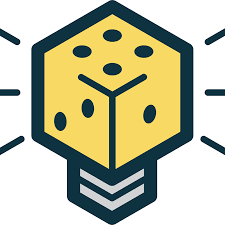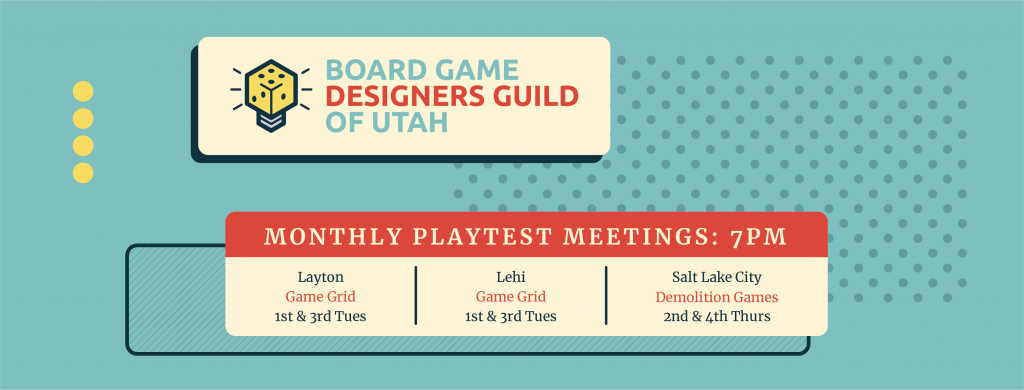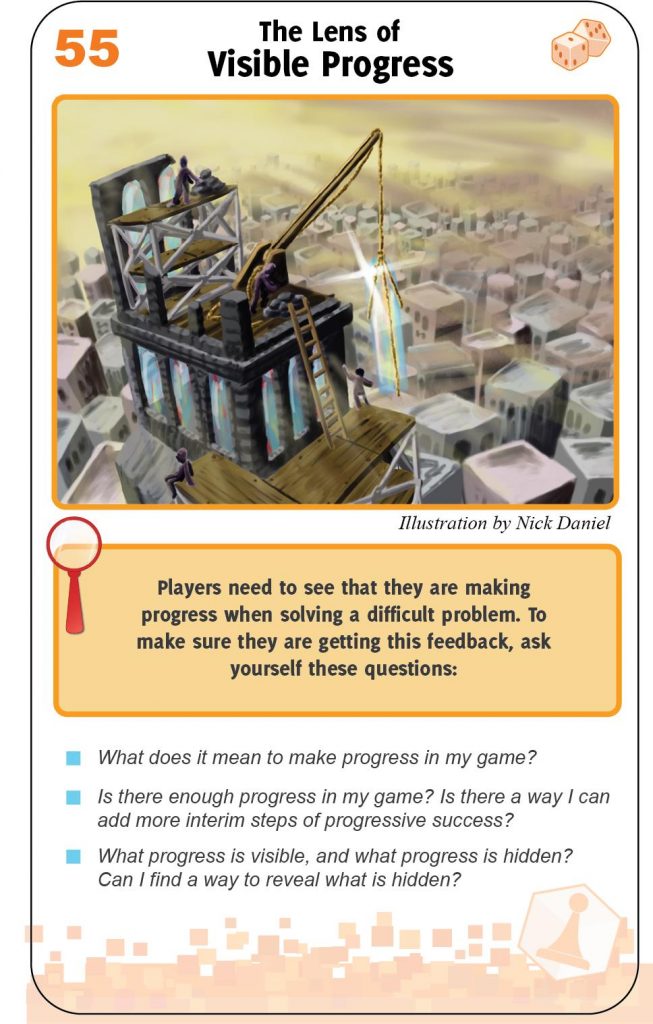Guild Update

Guild Playtest Meetings

Discord and the Guild
The BGDG of Utah’s Discord is a great way to get to know those in the guild and discuss all things game design! If you’ve not joined yet, we’d love to have you come and participate with us!
BGDG of Utah Social Media
We have an active Twitter and Instagram account now! Please follow and start using #bgdgofutah in your game design related posts and they will be liked, retweeted etc!
Upcoming/Current Events
Current Design Contests
| Contest | Host | Deadline | Design Restrictions | Judges | Prizes |
|---|---|---|---|---|---|
| Roll and Write Design Contest | BoardGameGeek | 4/17/2022 | roll & writes | BGG community | GeekGold |
| Word up Challenge | The Game Crafter | 4/21/2022 | word games | Industry Panelists | design consulting & store credit |
| Children & Family Design Contest | BoardGameGeek | 4/30/2022 | family and kids games | BGG community | GeekGold |
| 54-Card Game Design Contest | BoardGameGeek | 4/30/2022 | 54 cards | BGG community | cash & publication consideration by Side Room Games |
| War Games Print and Play Contest | BoardGameGeek | 4/30/2022 | War Games | BGG community | GeekGold |
This table has been borrowed from Cardboard Edison
Board Game “Book Club”

If you enjoy talking about games on every level? Jon Walton has started a Board Game “Book Club” where those who want to participate in delving deeper into game design choices in published games can do so! Collectively a game is selected and time allotted for participants to play the game as many times as they like (including 0 times) then come together for a discussion! Feel free to participate with each game chosen or just participate with the games you most enjoy when they are selected. The discussion takes place on the BGDG of Utah’s Discord.
The next game we will be discussing is Res Arcana! The discussion will take place this Thursday (03/31/22) at 8 pm so be sure to cast your vote! We’d love to have some additional voices to the discussion if you are interested in participating!
Guild Related Videos, Games and Podcasts
Snack Time was fully funded on Kickstarter recently.
Now or Never was featured in Jamie Stegmaier’s video of his favorite mechanisms!
Ryan and Malorie Laukat were featured on this board game quiz show!
The Board Game Community Show features Tim Fowers!
Game Design Highlights
Tips for Adjusting Randomness in Card Games
by: Aaron Treglown (Thunder Finch Games)
One of the most common and useful applications for cards in game design is for introducing hidden information and uncertainty into designs. Cards create uncertain game states such as what card you will draw next, or what card is in your opponent’s hand, and uncertainty is a powerful tool for creating challenging and interesting decisions. Too much uncertainty though can have the opposite effect, resulting in decisions feeling random and meaningless. Here are a few game design tips for optimizing the amount of uncertainty/randomness that is in your card game.
Below is a table I created with typical card game design options in order of decreasing randomness.
| Methods to Gain Cards | Randomness | Complexity | Player Interaction | Popular Games |
| Shared Deck | High | Low | Low | Schotten Totten, Exploding Kittens, Arboretum, Munchkin |
| Draw and Choose Which to Play/Keep (Shared Deck) | Medium-High | Low | Low | Ticket to Ride (Destinations), Fireball Island the Curse of Vul-Kar, Love Letter |
| Face-Up Shop with Generic Cost to Claim | Medium | Medium-Low | Medium | Ticket to Ride (Trains), Century Spice Road (Trade Cards), Architects of the Coliseum |
| Draft | Medium | Medium | Medium-High | Sushi Go, 7-Wonders, Seasons, Bunny Kingdom |
| Individual Player Decks | Medium | Medium | Low | Imperial Settlers, Exceed, Magic the Gathering |
| Unique Cost to Play (Drawn from Shared Deck) | Medium | Medium | Low | Race for the Galaxy, Arcane Academy |
| Face-Up Shop with Unique Cost to Claim | Low | Medium-High | Medium | Clank, Space Base, Century Spice Road (Score Cards), Dominion, Gizmos |
| Auction | Low | High | High | Power Grid, For Sale, Modern Art |
When designing a game, it is important to understand how valuable one card is towards victory compared to another. It can be frustrating for players if the value of cards they receive (either randomly, or by unintended design) is overwhelming lower than those received by their opponent. Difference in card value has the potential to completely overrule player choices and strategy in the outcome of a game- eliminating the fun. You can use spreadsheets math and probably to understand the value of cards in your game, but the easiest way to value cards is by comparison. Choose a couple of the most basic cards and abilities in your game and compare everything to them- are other cards nearly equivalent, two times, three times, or 4 times better than the basic card? After understanding the value of cards in your game you will have the necessary information to understand how much uncertainty and randomness is in your game. There are many successful card games that allow for a large amount of uncertainty and randomness in their design; these games usually play best at 3+ players, have high player interaction, and rely on the players to balance the game by ganging up on whoever is in the lead. It is up to you as the designer to understand your design and make an informed decision about what type of game experience you’d like to create.
Keep in mind that adding a cost to purchase or play a card adds a significant amount of complexity to a game. Rather than adding a cost value and economy to your cards, another solution to decrease randomness is to keep the values of cards drawn from a central deck relatively close together. In decks without costing, I recommend keeping all cards valued within half and double the average value of the deck.
Another technique that works well if there are two different values of cards in your game, is to split one shared deck into 2 different ones. You can then place restrictions on how cards are obtained from the deck that contains the more powerful cards. This is the technique used in Schotten Totten to separate powerful ability cards from the other generic cards appearing in the game- limiting plays of ability cards to no more than 1 more than the number played by your opponent.
Be careful how you use drafting and auctions in your card game designs. You may be tempted to include a draft or auction so that players balance the game, but this can be frustrating, especially for new players that are unsure the value of a card or ability. Drafting and auctions are best utilized in games where the value of a card changes frequently based on the game state or when cards will have drastically different values to different players. In great games with drafting and auctions they utilize it as a core mechanic, not as an add on for reducing randomness.
The number of cards obtained during the game will have an impact on randomness. During a game, the further players draw through a deck the more predictable (less random) the overall results will become. In Faction Fighters player’s eventually draw through their entire deck, making the uncertainty about when you will draw a certain card, not if you will.
Another useful tip I learned during the development of Faction Fighters is to balance your game at level the level of customization. For Faction Fighters players are allowed to swap entire factions in and out of their deck but not individual cards- as a result it was not important for each of the individual cards to be balanced only the three card faction groups. For games where the entire player deck is unique (such as Imperial Settlers) there can be a wide variety in card values within a deck and as long as the average advantages of the different player decks are equivalent. Keeping this concept in mind allows for introducing interesting variety to games with asymmetry and customization without adding too much randomness. Since most TCGs are customizable at the individual card level they need to adjust this approach and instead balance their games for viable strategic combinations. It is okay for a particular TCG card to be overpowered as long as the supporting cards that make it a viable strategy are not better than other strategies as a set. Occasionally a card is so versatile that it boosts every single strategy or will creates a divergent viable strategy that the designers didn’t foresee, and this is ultimately what lands a card on a TCG “ban” list.
My love for game balancing has been to the detriment of some of my early prototypes where I spent too much time on balancing before the game’s core systems were good. I’m more of a game developer than a designer, but I love parts of both parts of the process! I’m happy to share more ideas and thoughts for tackling challenges in your card game designs. Feel free to reach out to me with your designs. There is always something interesting to think about! Happy Designing!
Art of Game Design
These lenses from Jesse Schell’s book The Art of Game Design: A Book of Lenses, is a great way to view game design with new and varied perspectives. Each newsletter will feature a lens from the book and you are welcome to join in a discussion on the topic in the BGDG of Utah’s Discord!

